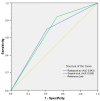Imaging and Clinical Parameters for Distinction between Infected and Non-Infected Fluid Collections in CT: Prospective Study Using Extended Microbiological Approach
- PMID: 35204585
- PMCID: PMC8870876
- DOI: 10.3390/diagnostics12020493
Imaging and Clinical Parameters for Distinction between Infected and Non-Infected Fluid Collections in CT: Prospective Study Using Extended Microbiological Approach
Abstract
The aim of this investigation was to evaluate predictive CT imaging features and clinical parameters to distinguish infected from sterile fluid collections. Detection of infectious agents by advanced microbiological analysis was used as the reference standard. From April 2018 to October 2019, all patients undergoing CT-guided drainages were prospectively enrolled, if drainage material volume was at least 5 mL. Univariate analysis revealed attenuation (p = 0.001), entrapped gas (p < 0.001), fat stranding (p < 0.001), wall thickness (p < 0.001) and enhancement (p < 0.001) as imaging biomarkers and procalcitonin (p = 0.003) as clinical predictive parameters for infected fluid collections. On multivariate analysis, attenuation > 10 HU (p = 0.038), presence of entrapped gas (p = 0.027) and wall enhancement (p = 0.028) were independent parameters for distinguishing between infected and non-infected fluids. Gas entrapment had high specificity (93%) but low sensitivity (48%), while wall enhancement had high sensitivity (91%) but low specificity (50%). CT attenuation > 10 HU showed intermediate sensitivity (74%) and specificity (70%). Evaluation of the published proposed scoring systems did not improve diagnostic accuracy over independent predictors in our study. In conclusion, this prospective study confirmed that CT attenuation > 10 HU, entrapped gas and wall enhancement are the key imaging features to distinguish infected from sterile fluid collections on CT.
Keywords: CT; abscess; attenuation; drainage; gas entrapment; infection; wall enhancement.
Conflict of interest statement
The authors declare no conflict of interest.
Figures




Similar articles
-
Distinguishing infected from noninfected abdominal fluid collections after surgery: an imaging, clinical, and laboratory-based scoring system.Invest Radiol. 2015 Jan;50(1):17-23. doi: 10.1097/RLI.0000000000000090. Invest Radiol. 2015. PMID: 25198832
-
Infected versus sterile abdominal fluid collections in postoperative CT: a scoring system based on clinical and imaging findings.Abdom Radiol (NY). 2020 Sep;45(9):2871-2878. doi: 10.1007/s00261-020-02635-y. Abdom Radiol (NY). 2020. PMID: 32671442
-
Value of spectral detector computed tomography to differentiate infected from noninfected thoracoabominal fluid collections.Eur J Radiol. 2021 Dec;145:110037. doi: 10.1016/j.ejrad.2021.110037. Epub 2021 Nov 16. Eur J Radiol. 2021. PMID: 34808580
-
CT Texture analysis and CT scores for characterization of fluid collections.BMC Med Imaging. 2021 Dec 6;21(1):187. doi: 10.1186/s12880-021-00718-w. BMC Med Imaging. 2021. PMID: 34872524 Free PMC article.
-
Visceral adiposity and inflammatory bowel disease.Int J Colorectal Dis. 2021 Nov;36(11):2305-2319. doi: 10.1007/s00384-021-03968-w. Epub 2021 Jun 9. Int J Colorectal Dis. 2021. PMID: 34104989 Review.
Cited by
-
CT-Based Radiomic Analysis May Predict Bacteriological Features of Infected Intraperitoneal Fluid Collections after Gastric Cancer Surgery.Healthcare (Basel). 2022 Jul 10;10(7):1280. doi: 10.3390/healthcare10071280. Healthcare (Basel). 2022. PMID: 35885807 Free PMC article.
-
Computed tomography texture analysis to discriminate fungal and non-fungal infected fluid collections.J Med Imaging (Bellingham). 2023 Nov;10(6):064002. doi: 10.1117/1.JMI.10.6.064002. Epub 2023 Nov 9. J Med Imaging (Bellingham). 2023. PMID: 38074630 Free PMC article.
-
The empty pelvis syndrome: a core data set from the PelvEx collaborative.Br J Surg. 2024 Mar 2;111(3):znae042. doi: 10.1093/bjs/znae042. Br J Surg. 2024. PMID: 38456677 Free PMC article.
-
Automated Detection of Necrotizing Soft Tissue Infection Features by Computed Tomography.Diagnostics (Basel). 2025 Aug 13;15(16):2030. doi: 10.3390/diagnostics15162030. Diagnostics (Basel). 2025. PMID: 40870881 Free PMC article.
-
Radiological and Imaging Evidence in the Diagnosis and Management of Microbial Infections: An Update.Cureus. 2023 Nov 13;15(11):e48756. doi: 10.7759/cureus.48756. eCollection 2023 Nov. Cureus. 2023. PMID: 38094521 Free PMC article. Review.
References
-
- Politano A.D., Hranjec T., Rosenberger L.H., Sawyer R.G., Tache Leon C.A. Differences in morbidity and mortality with percutaneous versus open surgical drainage of postoperative intra-abdominal infections: A review of 686 cases. Am. Surg. 2011;77:862–867. doi: 10.1177/000313481107700720. - DOI - PMC - PubMed
LinkOut - more resources
Full Text Sources
Miscellaneous

